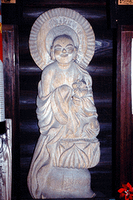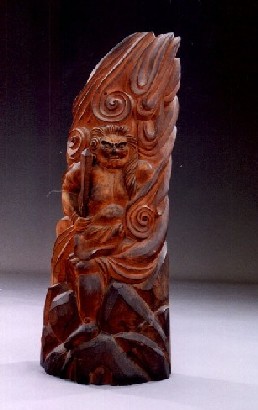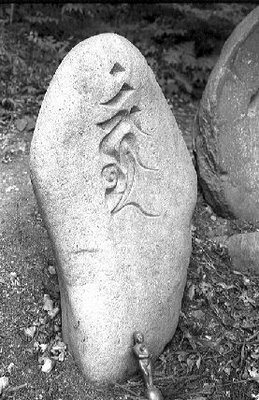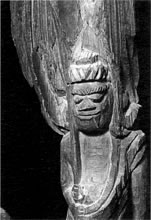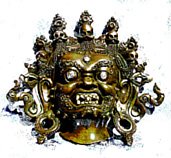[ . BACK to DARUMA MUSEUM TOP . ]
:::::::::::::::::::::::::::::::::::::::::::::::::::::::::::::::::::::::::::::::::::::::::::::::::::::::
Me-aka Fudo, the Red-eyed Fudo 目赤不動
One of the Fudo with five different eye-colors of Edo. For LINKS, see below.
Temples to these five Fudo were constructed by the third Shogun Tokugawa Iemitsu to protect the town of Edo.
Meaka Fudo was called as
Akame Fudo before it was moved to Hon-Komagome 駒込. Iemitsu had the Meaka Fudo installed at Do-Zaka 道坂 on the way to his grounds for hawk hunting.
The color red was associated with the element fire.
Recapitulate the basics of the five colored Fudo.
Below is also the Red Fudo, Aka Fudo.
:::::::::::::::::::::::::::::::::::::::::::::::::::::::::::::::::::::::::::::::::::::::::::::::::::::
At Temple Nankoku-Ji 南谷寺
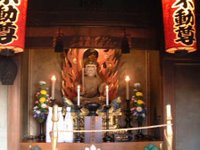 南谷寺
南谷寺
当寺は不動尊をもって廻国していた伊賀赤目山の住職満願が元和年間(1615-24)に下駒込村動坂で庵を結んだことに始まる。寛永14年(1637)鷹狩の折にこれを目にとめた三代将軍徳川家光が、現地に寺地を与えたという。
本尊の不動尊は目赤不動と呼ばれ、江戸の五色不動の一つで、既に十七世紀末から十八世紀前半の案内記で名所として取り上げられている(「江戸名所記」他)。
五色とは青・黄・赤・白・黒で梵語で言う地・水・火・風・空をあらわし、家光がこの五色不動の目として東西南北中央の五方眼で江戸を守るために五色不動を設定したという説がある(夏山雑談)。しかし実際には色と方角が一致せず、目黄不動が3ヶ所もあるなど、この説には疑問も多い。
 http://bird.zero.ad.jp/~zam77093/goshikimeaka.htm
............................. More Japanese Links
http://bird.zero.ad.jp/~zam77093/goshikimeaka.htm
............................. More Japanese Links

目赤不動尊は、 もとは赤目不動尊と言われていた。 元和年間(1615~24) 比叡山の南谷(みなみだに)に万行律師がいて、 明王を尊信していた。ある夜、伊勢国(三重県)の赤目山に来たれとの夢見があり、赤目山に登り、 精進を重ねていた時、虚空から御声があって、一寸二部の黄金造りの不動明王像を授けられた。
赤目山を下り、比叡山南谷の庵室に安置した。しばらくして「黄土衆生の志願を起こし」関東に向かい、下駒込(いまの動坂)に庵を結んで、万民化益を祈念した。参詣の諸人は奇瑞を得て群参した。
寛永5年(1628)、 三代将軍家光が鷹狩りの途中、 立ち寄り、「御徳御尋になり由来を言上したところ、府内五不動の因縁を以て赤目を目赤と唱へる様にとの上意が」あり、 現在の地を賜った。
後に、寺院を建立して、智證大師作 不動明王を御前立に安置した。以後、目赤不動尊として、 「年を超え月を重ねて利益日々に著しく参拝の諸人絶えること」がない。 としています。

目赤不動 駒込浅香町にあり。伊州〔伊賀国〕赤目山の住職
万行(まんぎょう)和尚(満行、?~一六四一)Priest Mangyo
、回国のとき供奉せし不動の尊像しばしば霊験あるによつて、その威霊を恐れ、別にいまの像を彫刻してかの像を腹籠(はらごも)りとす。
将軍家光と関連し、最初は「赤目不動」であったのが、「目赤不動」になったとします。そのきっかけは、「府内五不動の因縁を以て」(縁起)、「目黒、目白に対して」(江戸名所図会)として、五色不動設定との関連を示します。堂には、上のような平成7年の大きな奉納額があり、いまもって不動信仰のなみなみならぬものを告げています。
Akame Fudo
. Mangyoo 満行 / 万行和尚 Priest Mangyo . .
満行大権現 Mangyo Daigongen / 満行権現 Mangyo Gongen
榛名大明神 Deity Haruna Daimyojin / Gunma
http://www.ne.jp/asahi/suehiro/morgen/gosyokufudo/meakafudo.htm
http://humsum.cool.ne.jp/hakusan.html 白山神社と赤目不動
http://www.tenchi-web.com/fcmemo/seichi/19.html
Close to Nankoku-Ji, there is a temple with an Enbiki-Jizoo for drawing your good luck.
近くのお寺で「縁引地蔵」があります。
:::::::::::::::::::::::::::::::::::::::::::::::::::::::::::::::::::::::::::::::::::::::::::::::::::::
Aka Fudou - The RED FUDO 赤不動

The chief of the Five Great Myoo and the Eight Great Myoo.
He appears in wrath; vanquishes all evil and renders virtue, making trainees decide to attain enlightenment. He has the power to make people attain enlightenment with the wisdom of Buddha. He was called Fudou (immobile) because he never moves in the perfect spiritual state of concentration in fire, vanquishing all kinds of sins. He appears in a child style; hanging down a pigtail of hair over his left shoulder with his left eye shut thin sitting on the rock. He also holds a sword of wisdom in his right hand, a rope in his left subduing earthly desires of ordinary people.
There exists the iconography of Esoteric Buddhism in Giki (the book of secret ritual practice), however, many of them are created freely. He was attended by Kongara Douji and Seitaka Douji. Gurikara Fudou appears not in Myoo, but a dragon (Gurikara Myoo) coiling itself around the sword of wisdom thrusting on the rock and trying to swallow the sword from its top. The color of the skin of Fudou Myoo is generally the one of ditch mud's explaining that he saves ordinary people living in the indecency world, however, yellow, red, or blue Fudo Myoo are sometimes worshipped.
Copyright (C) 2005 KURITA TRADING CO.,LTD
http://www.butuzou.co.jp/english/akafudo.html
:::::::::::::::::::::::::::::::::::::::::::::::::::::::::::::::::::::::::::::::::::::::::::::::::::::
aka Fudoo Myoo Oo 赤不動明王
Red Fudo

about 15 cm high
made by
. Bokuda Shuu-un 牧田秀雲 Bokuda Shu-Un .
:::::::::::::::::::::::::::::::::::::::::::::::::::::::::::::::::::::::::::::::::::::::::::::::::::::
明王院(赤不動)
Meioo-In, Aka-Fudo, Red Fudo Temple
Adachi Ward, Tokyo
源為義の三男、帯刀先生(たてわきせんじょう)志田三郎義広が 創建したという古刹。
ところ:足立区梅田4-15-30
http://www.geocities.co.jp/Bookend/1036/adachi/meiouin.html
:::::::::::::::::::::::::::::::::::::::::::::::::::::::::::::::::::::::::::::::::::::::::::::::::::::
高野山別格本山 赤不動明王院 Aka-Fudo
Red Fudo at Myo-O-In, Mt. Koya

It was originally opened at the time Kukai founded Koyasan enshrining as a central deity and image of Godai Myoo. The image was lost to a fire in 1631, however, and presently there is enshrined a painting of a
red Fudo Myoo said to have been painted by
Chisho Daishi Encho. He used red mineral pigments mixed with his own blood.
近畿三十六不動尊霊場三十五番札所・日本三不動一番札所・壇上伽藍鬼門鎮護の五大堂
日本三不動のひとつとして知られる
赤不動明王を本尊としてお祭りしています。
本尊の赤不動明王は、いわゆる感得像で、赤い身色の不動明王を二童子と共に描いた画幅です。弘法大師の甥に当たられる方で、後に天台の座主にもなられる
智証大師円珍和尚が、修行中に感得した不動明王の姿を、その余りの有り難さに自分の頭を岩に打ち付け、岩絵の具に頭血を混ぜて写しとられたと言われています。
赤不動明王は平安の昔より庶民に尊崇され厚い信仰を集めていたようです。例えば平安・戦国・江戸太平の頃…と高野山への帝・皇族・貴顕紳士の御登山は数多ありますが、明治維新以降、廃仏の嵐の中も不動尊信仰の濤は世に息むこと無く、天皇皇后両陛下をはじめ、各宮家や多くの華族が赤不動明王に礼拝供養されました。海外からも多数ご参拝頂いた様子で、大正時代の「高野山時報」にはスウェーデン皇太子御登山、として以下のような記事が載っています。
http://www.acala.jpn.org/
:::::::::::::::::::::::::::::::::::::::::::::::::::::::::::::::::::::::::::::::::::::::::::::::::::::
Quted from Mark Schumacher:
RED YOUTH 赤童子, AKADOUJI
(text courtesy JAANUS)
Literally "Red Youth." Also often called
Kasuga Akadouji 春日赤童子.
A mysterious human figure said to have appeared on a rock immediately in front of the Kasuga 春日 Shrine gate. He often is shown as a youth, douji, colored red, aka, standing on a rock, and leaning on a staff. In certain poses both in paintings and in prints, Akadouji resembles Kongoudouji 金剛童子, one of the attendants of Fudou Myouou 不動明王.
His connection with Kasuga is obscure, but he has been identified with Ame-no-Koyane 天児屋根, the God of the Third Sanctuary there; with Jinushi gami 地主神, the land god; with a healer's helping spirit; and with a thunder god of Mount Mikasa 御蓋, which stands behind the shrine at Kasuga. Extant images date from the Muromachi to Edo periods.
:::::::::::::::::::::::::::::::::::::::::::::::::::::::::::::::::::::::::::::::::::::::::::::::::::::
LINKS
Goshiki Daruma and Color Symbols 五色だるま ―色彩散歩 Gabi Greve
O-Fudo-Sama in Japan: Meguro Fudo Temple Gabi Greve
The Color Red in Japanese Mythology, by Mark Schumacher
:::::::::::::::::::::::::::::::::::::::::::::::::::::::::::::::::::::::::::::::::::::::::::::::::::::
painted in blood -
the Red Fudoo
speaks to my soul
Gabi Greve, 2004, January 28
Hatsu Fudoo
:::::::::::::::::::::::::::::::::::::::::::::::::::::::::::::::::::::::::::::::::::::::::::::::::::::::
. 関東三十六不動霊場 - Nr. 13
Pilgrimage to 36 Fudo Temples in Kanto (Bando) .
[ . BACK to DARUMA MUSEUM TOP . ]
[ . BACK to WORLDKIGO . TOP . ]
:::::::::::::::::::::::::::::::::::::::::::::::::::::::::::::::::::::::::::::::::::::::::::::::::::::::









